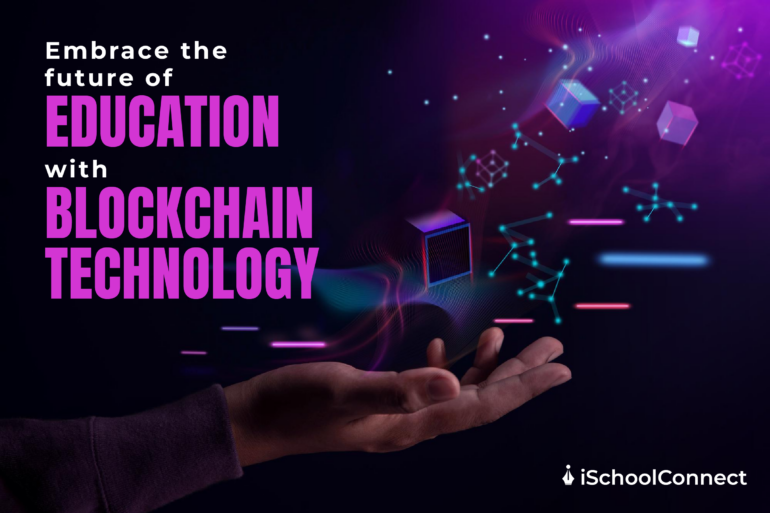Table of Contents
- Introduction to blockchain technology
- Blockchain technology | The basics
- How blockchain will disrupt the education sector
- Empowering credential verification and authentication
- Streamlining student mobility and transfer credits
- Enhancing accessibility to global learning
- Revolutionizing student identity and privacy
- Globalizing financial transactions and scholarships
- Fostering cross-border collaboration
- Overcoming challenges
- Key takeaways
- FAQs
Introduction to blockchain technology
In an era of rapid technological advancement, blockchain technology is a transformative force, disrupting traditional industries and revolutionizing processes across the globe. One area where it impacts the most is international education. As borders blur and education transcends geographical constraints, blockchain is paving the way for a more accessible, secure, and efficient global education ecosystem. In this blog, we will discuss the profound influence of blockchain technology on international education and explore its implications for students, institutions, and the education sector at large.
Blockchain technology | The basics
At its core, blockchain is a decentralized, immutable digital ledger that records transactions in a secure and transparent manner. Information stored on a blockchain is distributed across a network of computers, eliminating the need for a central authority and reducing the risk of data manipulation. Each block in the chain contains data, a timestamp, and a link to the previous block, ensuring the integrity and chronology of records.
How blockchain will disrupt the education sector
Education has changed dramatically, from traditional classroom settings to eLearning and now to blended learning. The COVID-19 pandemic hastened the adoption of digital learning, and schools all across the world have begun to teach students using online platforms and Learning Management Systems (LMSs). Blockchain technology has the potential to completely transform the education business. Blockchain has the ability to change academic data management methods, as well as how teachers and students interact. Let us find out how blockchain technology and its influence may impact schooling in the future.
Empowering credential verification and authentication

One of the most significant challenges in the world of international education is verifying the authenticity of academic credentials. With students and professionals seeking opportunities across borders, the need for a reliable and universally recognized method of credential verification has become essential. Blockchain provides a solution by enabling secure and tamper-proof verification of academic records. Educational institutions can issue digital certificates and diplomas on the blockchain, ensuring that credentials are easily accessible, verifiable, and immune to forgery. This not only simplifies the hiring process for employers but also enhances the credibility of qualifications for students pursuing global opportunities.
Streamlining student mobility and transfer credits
Studying abroad or transferring credits between institutions often involves complex administrative processes and lengthy verification procedures. Blockchain simplifies this by creating a transparent and efficient system for recording and sharing student data. When a blockchain stores academic records, institutions can seamlessly access verified information, enabling smoother credit transfers and facilitating student mobility across borders. This streamlined process saves time, reduces administrative burdens, and enhances the overall student experience.
Enhancing accessibility to global learning
The influence of blockchain technology on international education extends beyond administrative efficiencies. The technology has the potential to democratize access to education by providing a secure and accessible platform for educational content and resources. Blockchain-powered platforms can connect students with educators and institutions worldwide, enabling borderless learning. This is particularly impactful for regions with limited educational infrastructure, as students can access quality courses and materials remotely, bridging educational gaps and fostering lifelong learning.
Revolutionizing student identity and privacy
Student privacy and data security are critical considerations in today’s interconnected world. Blockchain offers a decentralized approach to managing student data, allowing individuals to securely control and share their information. Students can grant institutions access to specific data without compromising the entirety of their personal information. This enhanced control over data empowers students to manage their digital identities and protect their privacy in an era of increasing data breaches and online threats.
Globalizing financial transactions and scholarships
Financial transactions, including tuition payments and scholarship disbursements, often involve intermediaries, currency conversions, and delays. Blockchain’s inherent transparency and efficiency can simplify cross-border transactions, reducing costs and processing times. Smart contracts, self-executing codes stored on the blockchain, can automate processes such as scholarship applications and distributions, ensuring that funds allocation is accurate and transparent.
Fostering cross-border collaboration
Blockchain’s technical nature promotes collaboration and trust-building in the international education sphere. Institutions, organizations, and governments can collaborate more effectively by securely sharing data and resources. This collaborative environment can lead to joint research initiatives, curriculum development, and the sharing of best practices. This will ultimately enrich the educational experience for students worldwide.
Overcoming challenges
While the potential of blockchain in international education is vast, challenges do exist. Technical integration, standardization of protocols, and ensuring data privacy are among the hurdles that need to be addressed for widespread adoption. However, the ongoing efforts to develop blockchain solutions tailored to the education sector are promising and can help make blockchain more feasible for the field of international education.
Read more: How does hybrid learning have a positive impact on students and institutions?
Key takeaways
- Blockchain ensures secure, tamper-proof verification of academic records, enhancing credibility and simplifying hiring for employers and students seeking global opportunities.
- Blockchain’s transparency and efficiency simplify cross-border financial transactions, reducing costs and enabling accurate, automated processes such as scholarship distributions.
- While challenges exist, ongoing efforts to tailor blockchain solutions for education hold promise, making adoption in international education feasible.
Did this blog interest you? We’d love to hear your thoughts in the comments section below. Our team is here to assist those intrigued about international education opportunities or if you have questions about the same. Click here to connect with us!
Liked this blog? Read next: All about studying in Maynooth University
FAQs
Q1. What are the main blockchain networks?
Ans- Blockchain networks are of four types. They are public blockchains, private blockchains, consortium blockchains, and hybrid blockchains. Each of these platforms has advantages, disadvantages, and ideal applications.
Q2. Who invented blockchain?
Ans- In 2008, a person identified as Satoshi Nakamoto proposed the first decentralized blockchain.
Q3. Where is blockchain used today?
Ans- There are some noteworthy blockchain uses in the public and private sectors of the government. They are healthcare, supply chains; media; and financial institutions, including banking services.






